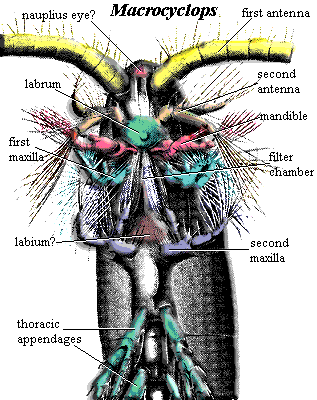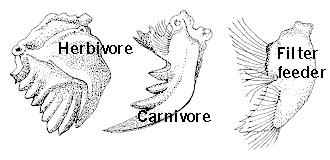| Arthropoda | ||
| Metazoa | Mandibulata |
| Arthropod Phylogeny | Arthropoda
├─Chelicerata
└─► |
Pancrustacea | |
| Chelicerata | ◄─┬─Atelocerata
└─Crustacea |

The Mandibulata is a fairly old proposal that distinguishes those arthropods, such as insects and crustaceans, that posses biting jaws (mandibles), from the chelicerates which developed pincers instead (e.g. spiders). Specifically, the mandibles of the mandibulates are derived from the legs of the third or fourth segment. In addition, all mandibulates have groups of eight cells in the retinula of the compound eye, if one exists. They may be uniramous or biramous (one or two pairs of legs per segment), one or two pairs of antennae, and two or three main body segments.
The general arrangement of the mouth parts is shown for the copepod (Crustacea) Macrocyclops, adapted from Barnes (1968). Crustacea have two pairs of antennae. In insects, there is only a single pair. One of these pairs is expected to be the homologue to the chelicerae of the Chelicerata. Behind the antennae is a single median labrum, a sort of upper lip analogue formed by the fusion of a pair of appendages. Like the upper lip of the proverbial Englishman, it is stiff, but moves rapidly when necessary. It covers the anterior rim of a preoral cavity. The mandibulae come next. Their form is quite variable, depending on the organism's diet. Macrocyclops, as a filter feeder, has biramous mandibles bearing long, setae. The mandibles form the sides of the preoral cavity.
Behind the mandibles, Mandibulata bear one, or more typically, two pairs of maxillae, frequently with a long palp, as in the second maxilla of Macrocyclops. Insects close off the posterior of the mouth with a second "lip," the labium. Macrocyclops appears to have some sort of analogous structure posterior to a long post-oral filter chamber.
Insect mandibles are unjointed. As noted, their form is strongly indicative of the organism's diet and mode of life. Several examples are shown in the table below.
The point of all this discussion is not simply to flap our own mandibles, but rather to explain the range of characters that strongly suggests that this group is closely related. How they are related is less clear.
ATW040919. Text public domain. No rights reserved.
As originally proposed, the arrangement of the Mandibulata looked like this:

The above position was first advocated by Snodgrass and still has supporters today.
In 1958 Tiegs and Manton, and later Manton alone, presented a persuasive polyphyletic approach that showed that the jaws of insects and myriapods on the one hand, and chelicerates and crustacea on the other, cannot have the same evolutionary history. This meant that the old dichotomy of "Antennata"/"Mandibulata" as opposed to "Chelicerata" has to be rejected. It was assumed that insects and crustacea arose from completely different soft-bodied animals. Now the pendulum has swung the other way, with molecular and anatomical evidence indicating that the arthropods did evolve from a common ancestor, the even the Mandibulata has come back into favor. These phylogenetic studies use molecular analysis show Crustaceans and Atelocerata (insects and myriapods - essentially Manton's Uniramia sans the Onychophora) form a natural group. But supporters of Mandibulata disagree whether the Atelocerata itself is monophyletic or not. (see rival phylogenies)
Phylogeny of Arthropoda after Giribet et al., 96, Giribet, et al., 2001, etc
Paleontological evidence, In contrast to the neontologic studies, shows that the Mandibulata are probably not a natural clade. Wills et al. comprehensive morphological analysis of both extant and Cambrian taxa rejects the Mandibulata and presents instead the Arachnomorpha as a sister group to the Crustacea.
More problems for the status of the Mandibulata come from the Swedish Upper Cambrian "Orsten" forms (larval arthropods) feature exquisitely preserved three-dimensional soft parts and rank among the most important extinct arthropods ever discovered. Many of the "Orsten" taxa are considered stem-group crustaceans and are of great importance to the Mandibulata debate as they reveal that certain putative key synapomorphies of Mandibulata (e.g., the presence two sets of maxillae) do not, in fact, occur in stem-group crustaceans. (ref)